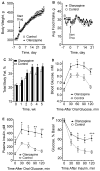Olanzapine promotes fat accumulation in male rats by decreasing physical activity, repartitioning energy and increasing adipose tissue lipogenesis while impairing lipolysis
- PMID: 20308992
- PMCID: PMC2892549
- DOI: 10.1038/mp.2010.33
Olanzapine promotes fat accumulation in male rats by decreasing physical activity, repartitioning energy and increasing adipose tissue lipogenesis while impairing lipolysis
Abstract
Olanzapine and other atypical antipsychotics cause metabolic side effects leading to obesity and diabetes; although these continue to be an important public health concern, their underlying mechanisms remain elusive. Therefore, an animal model of these side effects was developed in male Sprague-Dawley rats. Chronic administration of olanzapine elevated fasting glucose, impaired glucose and insulin tolerance, increased fat mass but, in contrast to female rats, did not increase body weight or food intake. Acute studies were conducted to delineate the mechanisms responsible for these effects. Olanzapine markedly decreased physical activity without a compensatory decline in food intake. It also acutely elevated fasting glucose and worsened oral glucose and insulin tolerance, suggesting that these effects are adiposity independent. Hyperinsulinemic-euglycemic clamp studies measuring (14)C-2-deoxyglucose uptake revealed tissue-specific insulin resistance. Insulin sensitivity was impaired in skeletal muscle, but either unchanged or increased in adipose tissue depots. Consistent with the olanzapine-induced hyperglycemia, there was a tendency for increased (14)C-2-deoxyglucose uptake into fat depots of fed rats and, surprisingly, free fatty acid (FFA) uptake into fat depots was elevated approximately twofold. The increased glucose and FFA uptake into adipose tissue was coupled with increased adipose tissue lipogenesis. Finally, olanzapine lowered fasting plasma FFA, and as it had no effect on isoproterenol-stimulated rises in plasma glucose, it blunted isoproterenol-stimulated in vivo lipolysis in fed rats. Collectively, these results suggest that olanzapine exerts several metabolic effects that together favor increased accumulation of fuel into adipose tissue, thereby increasing adiposity.
Conflict of interest statement
Figures




References
-
- Ananth J, Parameswaran S, Gunatilake S. Side effects of atypical antipsychotic drugs. Curr Pharm Des. 2004;10(18):2219–2229. - PubMed
-
- Ebenbichler CF, Laimer M, Eder U, Mangweth B, Weiss E, Hofer A, et al. Olanzapine induces insulin resistance: results from a prospective study. J Clin Psychiatry. 2003 Dec;64(12):1436–1439. - PubMed
-
- Haupt DW, Newcomer JW. yperglycemia and antipsychotic medications. J Clin Psychiatry. 2001;62(27):15–26. discussion 40-11. - PubMed
-
- Newcomer JW. Abnormalities of glucose metabolism associated with atypical antipsychotic drugs. J Clin Psychiatry. 2004;65(18):36–46. - PubMed
-
- Newcomer JW. Metabolic risk during antipsychotic treatment. Clinical therapeutics. 2004 Dec;26(12):1936–1946. - PubMed
Publication types
MeSH terms
Substances
Grants and funding
LinkOut - more resources
Full Text Sources
Other Literature Sources
Medical

